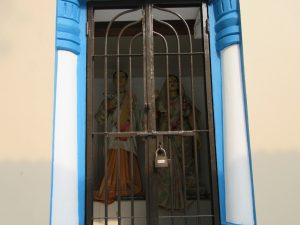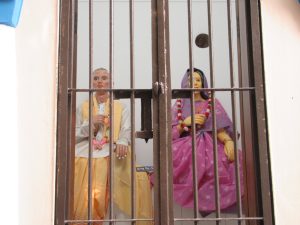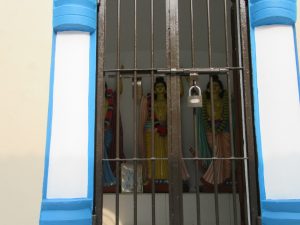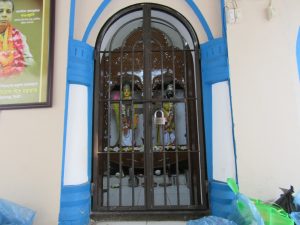By Priyan R Naik
 When I went to Sylhet in Bangladesh, I visited Dhaka Dakshin, a village in Sylhet district easily accessible from the city. I could see a compound with the silhouette of a decrepit old house on the verge of disintegrating. Visitors were not allowed to go anywhere near and the entire compound was barricaded to prevent trespass. Everyone was directed to a new building where several figurines representing the family of Chaitanya Mahaprabhu, the doyen saint of the ISKCON movement, were neatly lined up.
When I went to Sylhet in Bangladesh, I visited Dhaka Dakshin, a village in Sylhet district easily accessible from the city. I could see a compound with the silhouette of a decrepit old house on the verge of disintegrating. Visitors were not allowed to go anywhere near and the entire compound was barricaded to prevent trespass. Everyone was directed to a new building where several figurines representing the family of Chaitanya Mahaprabhu, the doyen saint of the ISKCON movement, were neatly lined up.
Worldwide, the ‘International Society for Krishna Consciousness’ or ISKCON has 500 major centers, temples and rural communities, nearly 100 affiliated vegetarian restaurants, thousands of local groups, a wide variety of community projects, and millions of members. ISKCON members open hospitals, schools, colleges, eco-villages, administer free food distribution projects as participants in devotional yoga. George Harrison, the lead guitarist of the ‘Beatles’, arguably the most influential band in the history of rock music, gave ISKCON publicity and financial backing, recording several tracks with members, where the ‘Hare Krishna mantra’ was included in his hit track “My Sweet Lord”. Shillong has an ISKCON temple at Rynjah, rather there are 9 ISKCON centers in the Meghalaya, Assam and Arunachal Pradesh zone.
 Propagated by Swami Prabhupada, the movement started when the Swami, at the age of 69, with barely 40 Indian Rupees in his pocket landed in New York in the 1960’s, preaching and chanting in public parks, attracting hippies and the youth. Life in New York for an elderly Indian gentleman was anything but easy. He had to preach to a western audience who had never heard about Krishna, delivering lectures on the Bhagavad Gita and distributing prasadam. Krishna Consciousness attracted all kinds of people who chanted the ‘Hare Krishna Mantra’ with full devotion. In a short span of time, the ISKCON society was officially registered in the State of New York. Later his movement, known as the “Hare Krishna Movement”, grew even larger when he relocated to San Francisco spreading soon to England. Swami Prabhupada established 108 temples and educational institutions propagating Krishna Consciousness in India and overseas.
Propagated by Swami Prabhupada, the movement started when the Swami, at the age of 69, with barely 40 Indian Rupees in his pocket landed in New York in the 1960’s, preaching and chanting in public parks, attracting hippies and the youth. Life in New York for an elderly Indian gentleman was anything but easy. He had to preach to a western audience who had never heard about Krishna, delivering lectures on the Bhagavad Gita and distributing prasadam. Krishna Consciousness attracted all kinds of people who chanted the ‘Hare Krishna Mantra’ with full devotion. In a short span of time, the ISKCON society was officially registered in the State of New York. Later his movement, known as the “Hare Krishna Movement”, grew even larger when he relocated to San Francisco spreading soon to England. Swami Prabhupada established 108 temples and educational institutions propagating Krishna Consciousness in India and overseas.
 A Western outgrowth of the popular Krishna Consciousness movement, it all began with the Bengali bhakti yoga tradition founded by Chaitanya Mahaprabhu, who advocated the pursuit of mystical devotion through repetitive chanting of the Hare Krishna mantra. This started being propagated in the 16th century, almost 500 years ago by engaging all people in worship regardless of caste and creed, publicly expressing devotion to Krishna, the Supreme God, through song and dance.
A Western outgrowth of the popular Krishna Consciousness movement, it all began with the Bengali bhakti yoga tradition founded by Chaitanya Mahaprabhu, who advocated the pursuit of mystical devotion through repetitive chanting of the Hare Krishna mantra. This started being propagated in the 16th century, almost 500 years ago by engaging all people in worship regardless of caste and creed, publicly expressing devotion to Krishna, the Supreme God, through song and dance.
Although Chaitanya Mahaprabhu, the founder of the Krishna Consciousness tradition was born in Nabadwip, in the Nadia district of Bengal, then an important center of learning and spiritual practice, his family came from Sylhet district. Born Vishvambhara Mishra he later became ‘Chaitanya Mahaprabhu’. As a young man, renowned for his deep devotion to Lord Krishna, his spiritual legacy and teachings found global acceptance through the ISKCON movement founded by Swami Prabhupada. The Mahapraphu’s father was an inhabitant of the village of Dhaka Dakshin in Sylhet. He went to Nabadwip for higher education returning to Sylhet to serve his aging parents. With Chaitanya due, his mother was asked to return to Nabadwip for Chaitanya to be born in consonance with his grand mother’s dream.
 It is here in Dhaka Dakshin that Chaitanya Mahaprabhu, his parents, grandparents and family members lived. Although their previous residence has been swallowed up by the jungle, the wall and a decrepit structure is visible. Chaitanya Mahaprabhu is now worshiped in a new temple, populated with the figurines of his parents and grandparents. Despite the crowds, I was overwhelmed with the solemnity of the temple compound buzzing with worshiping devotees, awed by the statuettes of Chaitanya Mahaprabhu’s family. Visiting Sylhet with its close association with the ISKCON movement, I am now determined to visit the Rynjah ISKCON temple in Shillong.
It is here in Dhaka Dakshin that Chaitanya Mahaprabhu, his parents, grandparents and family members lived. Although their previous residence has been swallowed up by the jungle, the wall and a decrepit structure is visible. Chaitanya Mahaprabhu is now worshiped in a new temple, populated with the figurines of his parents and grandparents. Despite the crowds, I was overwhelmed with the solemnity of the temple compound buzzing with worshiping devotees, awed by the statuettes of Chaitanya Mahaprabhu’s family. Visiting Sylhet with its close association with the ISKCON movement, I am now determined to visit the Rynjah ISKCON temple in Shillong.
******
(Priyan R Naik is a regular contributor to The Shillong Times)



